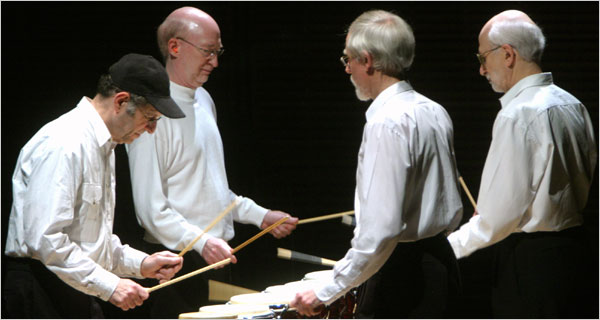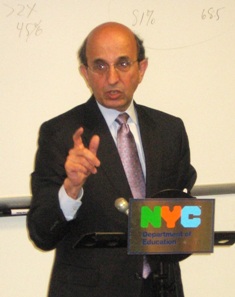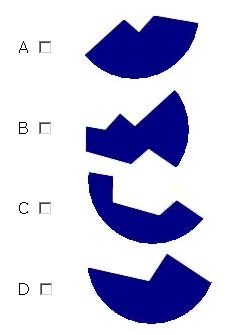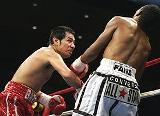Dewey 21C: April 2009 Archives
 While the stimulus money for education will pour significant funds into some schools, at the very same time other schools will see budget cuts. It's part of the schizoid time we live in. Moreover, some schools will have more money than ever for certain things and less for others. Arts Education is more than likely to be in the "less for others" category.
While the stimulus money for education will pour significant funds into some schools, at the very same time other schools will see budget cuts. It's part of the schizoid time we live in. Moreover, some schools will have more money than ever for certain things and less for others. Arts Education is more than likely to be in the "less for others" category.It's a simple calculus: cuts to contracted services for things like fees to cultural organizations, combined with cuts from the private funding side, have potential to remake arts education, and indeed arts organizations in ways that we do not yet understand.
It's less about hand-wringing, and more about trying to gauge where things are headed.
It's somewhat rare for USA Today to look at something related to arts education. Click here to read what I believe is but one canary in the coal mine: Cash Strapped Schools Cancel Field Trips.

Okay, of course we all know about teaching artists providing arts instruction in schools. We also know of non-arts teachers providing arts instruction (which predates the arts teacher). We also know, although it is still an outlier in arts education, of parents and other volunteers teaching arts.
Okay, here's a new one: a New York City public school, P.S. 37, cuts its certified music teacher because according to the principal: "we didn't have money for it." For over a year there was no music teacher, and of course, yes, the elmination of this arts teacher position predates the economic crisis. (Perhaps it was the elmination of dedicated arts funding that led to this situation?)
The principal canvasses parents to see if there's a volunteer, but no dice. So, along comes one of the students who takes over conducting the band.
Click here to read about it in the New York Daily News.
My colleagues and I have been developing a variety of materials to use in the informing part of the informed engagement. We have parent guides, fact sheets, legislation, coalition materials, and campaign letters, and much more coming down the pike.
Here's a draft of a piece that is both a tool to organizing constitutents, a key statement of beliefs, and something that inform the engagement. While we refine this, I thought it might be interesting to hear from the readers of Dewey21c. Let's call it infomed engagement.
In subsequent posts, I will talk a bit more about how this is all working.
Every Child in Every School
An Arts Education Bill of Rights
Every child in every school has the right to a well-rounded education, of which the arts are an essential ingredient. Beyond having great value in and of themselves, the arts promote the health and well-being of children, including academic and personal growth, critical thinking and analytical skills, and the motivation to stay in school and excel. Quality arts education is central to a complete education...and it is required by state education law.
A quality arts education helps students:
• Open doors of opportunity through the development of skills that are indispensable in the 21st century workforce;
• Foster an sense of personal identity and an appreciation for culture and community
• Develop as a person and global citizen;
• Become more expressive and creative and able to problem solve and work cooperatively
• Stay focused and engaged in school and learning
• Stay in school, achieve and excel;
The arts engage students and help transform schools into places of inquiry and wonder, where excitement, possibility, discovery, and imagination thrive. Every school must have the resources, leadership, parental involvement and public commitment needed to ensure that every child is able to realize the unique benefits of learning in and through the arts.
Every child in every school has the right to the fundamental components of a quality arts education, including:
1. Instruction by qualified teachers, enriched and strengthened by dedicated teaching artists and cultural institutions;
2. Facilities and classrooms that are adequately-equipped for arts education teaching and learning ;
3. Access to materials, supplies, equipment, instruments, and a rich array of cultural experiences;
4. The requisite amount of class time devoted to standards-based instruction in all art forms 5. The minimum instructional requirements for arts education as set forth in state education law.
We, the undersigned join The Center for Arts Education in supporting quality arts education for every child in every school.

Jane Remer's Cliff
Notes (Number Three): The Arts Just Don't Fit in Most
of Our Schools

Face it: The arts still don't fit in most of our schools and none of the
advocacy claims made for them have helped a whit in the last five decades. The
arts community - arts educators, arts organizations, artists who work with
schools, other friends of the arts--has tried and failed for years to make the
case for the arts in every student's life and learning environment. Claims
abound for the arts as important intellectual and experiential domains as well
as exceedingly effective instrumental bridges to other usually non-arts ends.
These claims are rarely backed up by solid empirical research and when they
are, the evidence is overwhelmingly correlational, not causal. These claims are
almost never made by school people, K-20 and beyond, and only occasionally
uttered by policy makers, whether top down legislators or bottom up teachers,
leaders and district superintendents.
What's going on here? After close to half a century of promise, inquiry,
research and development, assessment and evaluation, why does the arts
community persist in shouting its untested belief in the arts and their
influence on test scores, the local/national/global economy, or their power to
increase skills and abilities in other domains, both personal and scholastic?
And more recently, who do people who should know better claim that the arts
save lives, and yes, the world! Even the wonderfully simple 'habits of mind'
(which are not exclusive to the arts at all) that my serious colleagues Lois
Hetland and Ellen Winner recently identified in their on-going arts research at
Project Zero are now being paraded on stage by arts enthusiasts as "proof" of
the ominpotential power of the arts to ....well, you fill in the blanks.
I am tired of it. I am coming to the reluctant conclusion that even
after all the time, money and people resources we've spent trying to encourage
the embrace of the arts as core education, we are as far from our goals now as
we were fifty years ago. All the arts
for all the children - hah! It's still some if any of the arts in scattered
pockets of excellence, for some of the children, some of the time, taught by a
combination of people who can rarely work together as a team and who prize
different means, methods, ends and purposes. Yes, I am speaking of the blessed
classroom teachers, arts specialists, artists and parents who often valiantly
try to design some kind of curriculum that makes sense but rarely meets the
rigor of national standards or follows a coherent course of sequenced study.
It has dawned on me, perhaps finally, that for a multitude of reasons
that I will try to address in the "near future," the arts in
How do we endow
each child's arts learning with gravitas, and get more kids, their parents and
the rest of the school community interested in exploring the cognitive, social,
emotional, spiritual and aesthetic rewards of full immersion, over time, in
this rich domain. In other words, how
do we immerse kids in the many dimensions of arts learning such as making,
creating, connecting, performing, investigating, challenging and risk-taking
inquiry so they become connoisseurs (knowers) and masters (doers) in one or
more of the four major art forms?
I don't know the answer to these questions. I have worked in an on-site,
hands-on, intensive mode for many years in
Without the civic, political, economical and social infrastructure, it
is almost impossible for me to imagine a way through the thicket. I for one don't want to hang around for skimpy
handouts from the feds or count on other more New Dealish rescues which I don't
see in my foggy crystal ball.
Less advocacy, more action, locally. That's probably the best place to start.
*******************************************************************
JANE REMER'S CLIFF NOTES
We are at another rocky
precipice in our history that threatens the survival of the arts in our social fabric
and our school systems. The timing and magnitude of the challenges have
prompted me to speak out about some of the most persistent issues in the arts
education field during the last forty-plus years.
My credo is simple: The
arts are a moral imperative. They are fundamental to the cognitive, affective,
physical, and intellectual development of all our children and youth. They
belong on a par with the 3 R's, science, and social studies in all of our
elementary and secondary schools. These schools will grow to treasure good
quality instruction that develops curious, informed, resilient young citizens
to participate fully in a democratic society that is in constant flux.
I have chosen the title Cliff Notes for this forum. It serves as metaphor and double entendre: first, as short takes on long-standing and complicated issues, and second, as a verbal image of the perpetually perilous state of the arts as an essential part of general public education. I plan to focus on possible solutions and hope to stimulate thoughtful dialogue on-line or locally.
*******************************************************************
 Jane Remer has worked nationally for over
forty years as an author, educator, researcher, foundation director and
consultant. She was an Associate Director of the John D. Rockefeller 3rd Fund's
Arts in Education Program and has taught at Teachers College,
Jane Remer has worked nationally for over
forty years as an author, educator, researcher, foundation director and
consultant. She was an Associate Director of the John D. Rockefeller 3rd Fund's
Arts in Education Program and has taught at Teachers College, There was a time, a long, long time, when Reich didn't stand a chance to win a Pulitzer, as there was a stylistic bias against such music at the Pulitzer and any other number of important music awards. So many of my Reich favorites, Music for 18 Musicians, Drumming, Tehilim, Different Trains...they were never considered.
Reich won it, in 2009 for Double Sextet. If you want to see and hear a video of the work, click this link to NewMusicBox.
Hooray for Reich, for music, and for the Pulitzer Board.
I would now point you towards my blog last summer: How I Learned to Love Steve Reich.
Oh, and here's a link to an interview I did of Reich.
And finally, here's a link to an interview Steve Reich did of me (really!)
I would also like to mention that the runners-up were Don Byron, and my dear friend Harold Meltzer.

This week, the chancellor of the New York City public schools, Joel I. Klein, responded with a letter to the editor:

New York Schools: The Chancellor's Report Card
"The national tests she cites are not the measure of federal accountability, are given only to a small sample of schools, and are not aligned with New York State standards and therefore with what we teach in our classrooms. (That said, our fourth-grade scores on those tests are strong.)"
Debbie Meier, in case you're wondering, is considered by many to be the mother of the small schools movement, alongside many accomplishments in K-12 education.
(Lord knows, I've gone back to a blog or two I've written and wanted to insert a combination spelling, syntax, style, and grammar check into my brain...)
Nicholas Kristoff wrote an absolutely fascinating piece in today's Times about I.Q.
The piece is inspired by a new book by Richard Nisbitt: Intelligence and How to Get It: Why Schools and Cultures Count.
"Professor Nisbett provides suggestions for transforming your own urchins into geniuses -- praise effort more than achievement, teach delayed gratification, limit reprimands and use praise to stimulate curiosity -- but focuses on how to raise America's collective I.Q."There's a lot to consider here, perhaps most of all a book that looks at the impact of poverty on a child's performance in school and in life, and rather than address this reality through the single lens of testing, testing, testing, and higher standards, looks at a wide range of issues that are more appropriate to the role that schools and parents have traditionally played in the complex world of educating and developing people. It's less about the technical reforms beings discussed today and more about the art of teaching and learning and deeply considering what our children need. And, by the way, it's about the achievement gap too.
I would like to, for one moment, pair this piece up with a piece that I have always considered a primer on standardized testing. It come from my friend Robert Tobias, NYU Professor and former head of Research in the New York City Public Schools. The piece is Tobias's testimony to the New York City Council in 2005. It is, a must read, at the top of the list if you're interested in knowing more about what standardized tests do, don't, how they're gamed, and more.
Here are a few excerpts:
"Standardized tests are tools designed to measure a construct. That construct may be mathematics knowledge and skill, reading achievement, or mastery of state learning standards. In our zeal to raise test scores we have forgotten that the test is a measure of learning and reified the test score to the status of learning itself. The test score has become the coin of the realm and raising scores through any means has become the Holy Grail."
"...an unprecedented increase in test preparation has been widely reported, including the adoption of a new program of interim testing by the NYCDOE. Much of this test preparation is not designed to increase student learning but rather to try to beat or "game" the test. It may even serve to narrow learning by focusing instruction on the sample of content and formats used on the test rather than the broad and deep knowledge required by the standards. Thus, some of the improvement in scores may be because students have become better test takers rather than better learners."

This comes from a Chicago Tribune piece titled: Teacher Jobs and Reform Tops Duncan's List
...students asked questions about the economy and school programming. One asked how funding would continue for music and the arts.Indeed.
"It will take more resources and take more time," Duncan said.
And here's a little list from Gilbert and Sullivan:
It's the story about a smart and musically talented high school student who has dreams of pursuing a career as a violinist, but who will choose instead to enter the field of nursing. It appears as an all or nothing choice: music or nursing.
It's a well done story that looks at the life she leads, including the hours she works at the local Sonic, the preparations and excitement she and her fellow students feel as they head toward a national orchestra competition, the charge levied each parent for children to play in orchestras and/or participate in sports, and more.
It is a real story about a teenager overcoming significant challenges, and the price she pays as she succeeds.
The article made me think about the need to move arts and arts education towards life -long learning and participation. Tiffany Clay, the subject of this story, should have multiple pathways available to continue playing, as long as she wants, whether or not she becomes a professional musician, a nurse, a homemaker, or whatever.
The excitement of young people playing music, for the sake of music, the enjoyment and spirit and energy that emanates from performances such as the one covered in this story, is at the core of what pushes people to become professionals. That energy, excitement, sense of community and power. It's so much of why so many are excited by El Sistema.
Oddly enough, it's not what you find enough of once you enter the professional world. I had a friend who played in the pit of Cats for a decade, it certainly wasn't something he found there. Those gigs that you do, that are uninspired, are a long way from why you became a professional in the first place. I have had many friends in major orchestras, as well as freelancers, talk about the lack of inspiration, the long stretches between inspiration and tedium. And, yes, of course I understand that inspiration is by nature and definition not commonplace.
Does this inspiration have to end after high school, or college, or if you choose not to pursue music as a career?
There's been a bit more buzz over the past year or you about amateur arts making. I know of at least one foundation that is considering funding this area, and a number of the service organizations are looking at doing more around this.
I hope this area grows. It's really where my interest lies, in that I am much less concerned about developing professional artists, and much, much more concerned about making arts accessible and vital for everyone. There should and must be more pathways for the Tiffany Clays of this world to play in community orchestras, and be able to be part of what they love, for as long as their hearts' desire.
I ran an organization for seven years that was primarily concerned with composers. I learned a lot there about the the divide between amateur and professional, as so few composers make a living exclusively from their composition. In a way, it's a field that could be called a field of amateurs. Charles Ives, considered the father of modern music, he stopped composing at the age of 45, and went on to invent the modern version of the insurance business. My friend, Steven Albert, 1985 Pulitzer Prize winner: he sold stamps. Others teach, copy music, run music schools, etc.
If we were to go by a strict definition of professional versus amateur, Ives and Albert, and so many others would have to be considered amateurs. (I once read an interview where Pierre Boulez described Ives's music as that of an amateur...)
So, what I am saying? I am saying that the divide between amateur and professional is less defined than most people think, and that the vitality and community of art making in America should be accessible and commonplace to a much greater degree than it is today.
If I were King of the Forest, I would make this the center of my national cultural policy.

Click here to watch Ford Foundation President Luis A. Ubiñas introduce the new plan.
"A comprehensive set of new strategies aimed at creating fairness and equity for people everywhere."
What's in it for the arts, you may ask:
Supporting next-generation arts institutions
Arts and culture play a vital role in the creation of more just and vibrant societies. Our work aims to promote public discourse, cultural pluralism and artistic creativity through the development and sustainability of exemplary arts facilities and key networks, particularly in diverse communities. Throughout the world, independent arts organizations are emerging and creating unique and vitally needed spaces where citizens interact in an expanded public sphere. We support exemplars of a new 21st-century arts leadership who share knowledge, build capacity and serve as models of artistic innovation, cultural collaboration, inclusion and social partnership.
Orlando Bagwell, Director
Cultural legacies, memory and social change
Countries around the world continue to struggle to come to terms with legacies of war, enslavement, colonialism, discrimination and other crimes against justice, human dignity and freedom, and how that history shapes current discourse. We believe that historical sites, museums, archives, media products and cultural institutions are uniquely important in excavating the histories of the human struggle and reintroducing them into public consciousness and debate. We support the development of a global network of "sites of conscience" central to public exploration of memory and history. These sites seek to enable both historical and contemporary narratives to be constructed in more pluralistic ways, using methods that bring together marginalized and mainstream voices to shape complete and inclusive notions of national identity.
Orlando Bagwell, Director
What's in it for arts education? That's not so easy to tell. The Ford Foundation, somewhat quietly over the past five or six years, has been running one of the finest arts education initiatives I have ever encountered. While that program is in a sunset mode, fingers crossed that there will be room for arts education in Ford's new work.
Transforming secondary education
In today's global economy, young people who fail to get high-quality secondary education face increasingly dim prospects. Millions of students from marginalized groups are essentially barred from economic, social and political opportunity because their schools do not adequately serve them. Our work seeks to dispel two myths: that high-quality education is a scarce commodity and that inequalities among our schools are inevitable and intractable. We work with national, state and local partners to supplant these myths with durable evidence and powerful examples of equitable, high-quality schooling for all students. We also support parents, community groups, educators and others seeking to use evidence and examples to achieve policies and practices that provide fair and adequate school funding; recruit, prepare and retain high-quality teachers; expand classroom time and learning opportunities in the school day and academic year; and create meaningful accountability.
Jeannie Oakes, Director
Building knowledge for social justice
The current economic crisis and political transition in the United States have kindled in the nation an opportunity to rebuild a social contract around fairness and opportunity, collective responsibility and the common good. This will not happen, however, without compelling ideas, evidence and arguments that inspire and inform concrete steps toward a society where all have fair and decent work, where difference doesn't mean exclusion and disadvantage, and where all participate in democratic civic life. Toward that end, we support think tanks, public intellectuals, scholars and media to create and communicate knowledge for social change. We also support the development of the next generation of public intellectuals and leaders whose work can inform and sustain a social contract based on justice.
Jeannie Oakes, Director

"We have to do more with the arts...we have to do more with music..." It's for the record, click on the video below to hear Duncan say it.
Oh, did I mention I like Neko Case. She's good...
There has been quite the public relations effort nationally and internationally on behalf of Mayor Bloomberg and Schools Chancellor Joel Klein to sing the praise of the current version of school governance in the Big Apple. And, just last week we have heard from Arne Duncan, Secretary of Education, that the law should be renewed as is, for New York City is making great progress thanks to this form of mayoral control of the schools.
In today's New York Times, Diane Ravitch takes up this issue head on, looking closely at the record and history. This is truly a David and Goliath battle, when you think of Diane, as an individual without a staff, up against Michael Bloomberg, who has a staff member or two.
 Click here to read Diane's opinion piece in today's New York Times.
Click here to read Diane's opinion piece in today's New York Times. But before you do, I'll offer this one thought for the moment about mayoral control of schools, particularly the kind we have here in New York City. I never liked the idea of creating law and policy based upon an individual personality.It's a bad idea. In many ways, I think some people like mayoral control of schools in New York City because they like and trust Michael Bloomberg. So, they fight for it because they're fighting for Bloomberg.
What if the next Mayor were one of the recent corrupt or inept politicians who have taken a fall in recent years? Those checks and balances Diane Ravitch argues for, for which the current administration abhors, may be just the thing that prevents an absolute disaster. Do people really want absolute control, with virtually no checks and balances in the hands of one person, and the only chance for real accountability is by either having them removed from office, or not voting for them if and when they run for election?
Plus, there's something that I find hard to swallow in the argument that if you change the law governing the schools, if you tweak it one bit, the whole thing will come crumbling down. No hyperbole here, I was on a panel at NYU looking at school governance and that was the centerpiece of what a representative from the mayor's office posited.
Okay, here's the link again, to the David, in this David and Goliath of David and Goliath battles.


At first it was to be a regular high school to help with overcrowding in the area.
Then it became part of the Grand Avenue redevelopment led by Eli Broad, leading to the building of a $242 million state of the art facility. It was to become the "Fame" high school for Los Angeles.
Then it became a zoned arts high school for kids in the neighborhood. But not so fast, the school board ruled that 300 of the 1700 slots would be opened up district-wide.
They tried to hire an executive director. No dice.
Then they tried to hire a principal. No dice.
Now, get this, Ray Cortines, LAUSD Superintendent is having a public spat with none other than Eli Broad, a champion of charter schools, who is demanding that the school be converted to a charter:
"Cortines complained about an e-mail he said he received from Broad that was disclosed in an article in the Downtown News. Cortines said Broad told him that if the district did not give up control, "'the school is deemed to be mediocre and a failure.'"Click here for the LA Times coverage of this school, which still retains the working name: High School No. 9.
Perhaps they would be better with the working title: High School Number 9 from Outer Space, as in Plan Nine from Outer Space.
I've read a lot about Arne Duncan being a basketball player, but hadn't heard much about him liking to mix it up.

Yesterday Duncan spoke at a press conference in Maryland where he outlined what will be required of states in order to receive the second round of stimulus money. The Secretary is going to require significant reporting from each state on a number of key indicators.
There's a lot more here to the story that meets the eye: one of the requirements will be for states to disclose how they are scoring on the National Assessment of Education Progress (NAEP), in addition to state and local tests. NAEP, long considered the gold standard, and a nationally uniform one at that, may be an early indicator as to how Duncan will seek to change NCLB, which has been widely criticized for having no uniform standard, since it allows states to design and run their own tests. What is more, many see a number of states having watered down their tests to cover up the truth about how their students are performing. Some districts that score well on the state tests, but poorly on NAEP, have dismissed NAEP. Bu hey, that's politics, not research.
Oh, by the way, there is a NAEP arts assessment.
This is going to get very, very interesting.
Okay, when did Duncan land his blow?
In response to South Carolina's Governor Mark Sanford's exclamation that he would not accept over $500 million in education stimulus money, Duncan took a very big swing, let's call it a near knockout left hook by explicating K-12 data from South Carolina indicating that only 15% of African American students are proficient in math and their graduation rates are among the lowest in America.
Oh snap!
Duncan went on to say: "for South Carolina to stand on the sidelines and say that the status quo is O.K., that defies logic."
Click here to read the story in The New York Times.
And click below to have your block knocked off...
